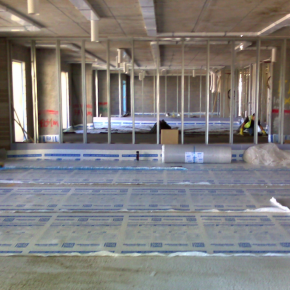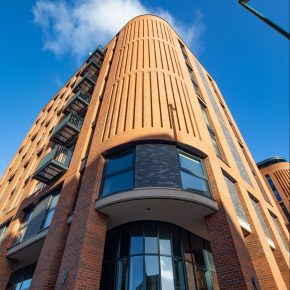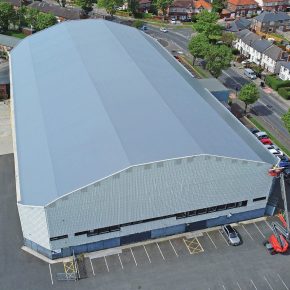
Tackling flanking sound transmission with Monarfloor Acoustics
Monarfloor Acoustics product development & business manager, Lee Nichols, discusses the issue of structure-borne noise in multi-occupancy buildings.
According to the World Health Organisation, noise is an ‘underestimated threat’ that can lead to multiple health problems. In the UK the number of complaints due to noise nuisance in domestic buildings is constantly growing.
One of the biggest problem areas is flanking sound. Flanking sound is noise that takes an indirect path, perhaps through the structural frame of a building, or through voids beneath floors or within walls. It could be the sound of a barking dog, dancing feet or a humming hoover that travel from one part of a building to another and cause annoyance.
For those who do want to improve the sound insulation performance of their buildings, one of the best ways to do that is through addressing flanking transmission. Below are some of the things to think about:
1. More mass
Generally, more mass reduces flanking transmission problems – making concrete floor with masonry walls the ideal solution. In addition, adding mass in other ways, such as using denser blockwork or thicker floor slabs, always helps.
However, this can be difficult in lighter forms of construction and ‘off-site’ such as steel-framed or timber-framed buildings. Designers need to take extra care when using modern methods of construction.
2. Divide and conquer
To stop sound travelling, you must break up continuous elements. For example, the traditional way to isolate adjacent semi-detached or terraced houses is to split the floor slab at the point of the party wall. In many cases, that isn’t a good option because it adds cost in additional foundations to support the edges of the slab and more material to excavate.
In that situation, a proprietary acoustic Isolation system for party walls, such as Bridgestop, can lead to savings of between 14% and 35% of foundation costs. Bridgestop incorporates an insulating membrane that goes on top of the floor slab, underneath the party walls, and a quilt that is installed on the cavity-side of one of the party walls.
Savings are most pronounced on brownfield sites where there is the additional cost of removing contaminated land. Where there is a gas or radon barrier, a proprietary acoustic isolation system can protect the barrier from potential damage due to mortar droppings.
3. Break the joints
To isolate the joints between walls and floors you can use an elastomeric interlayer, such as Monarfloor Wall Cap, where de-coupling isn’t possible. This interlayer sits over the top of a load-bearing wall, below the floor slab above it. Pre-completion sound insulation testing has demonstrated improvements of 8dB and more using this cost-effective and easy-to-install method – which is a very significant improvement in performance.
4. Think M&E
Mechanical and electrical installations can often be the source of flanking noise in residential buildings. In recent years, the drive towards higher levels of energy efficiency and air-tightness means that mechanical ventilation and heat recovery systems are being installed more often. Be sure to choose low-noise units and ensure that they are resiliently mounted to avoid vibration and noise. Risers too must be firmly fixed.
5. Inner linings
Acoustic floors reduce both impact and flanking sound transmission and are already a common solution. Products such as Monarfloor Tranquilt can be used as an isolation layer between the sub-floor and the finished screed.
We are seeing more demand for these systems, such as Monarfloor Wall Cap and Monarfloor Tranquilt, for high end attached dwelling, and buildings such as hotels, retirement complexes and build-to-rent apartment blocks. For some architects and specifiers, the fact that they are made from fully-recycled material is an extra bonus.
To conclude, there are cost-effective and straight-forward ways to reduce flanking transmission and hence greatly improve the environment for those living in or using the building. For new buildings, it is very important to design these measures in early, since retrofitting systems to reduce flanking transmission is expensive and often ineffective.
Visit Supplier's page
Latest news

23rd April 2024
Trio of Senior products used in new Nottingham residential scheme
Solutions from Senior Architectural Systems have helped complete The Barnum – a new residential development on Nottingham’s Queen’s Road.
Posted in Aluminium Products, Articles, Building Industry News, Building Products & Structures, Building Systems, Case Studies, Curtain Walling, Doors, Glass, Glazing, Posts, Restoration & Refurbishment, Retrofit & Renovation, Walls, Windows
22nd April 2024
New EJOT role will develop strategic support for UK flat roofing sector
EJOT UK has taken a major step in the expansion of its support for the flat roofing market by appointing one of its most experienced building envelope fastening specialists as its first sector-dedicated business development manager.
Posted in Articles, Building Industry News, Building Products & Structures, Building Systems, Innovations & New Products, Posts, Recruitment, Restoration & Refurbishment, Retrofit & Renovation, Roofs
22nd April 2024
Access2 Wins ADSA-Sponsored Award at AI Specification Awards
Access2 clinched the ADSA-sponsored Product Design and Innovation Award (Electronic) at the AI Specification Awards 2024 on Thursday.
Posted in Access Control & Door Entry Systems, Architectural Ironmongery, Articles, Awards, Building Associations & Institutes, Building Industry Events, Building Industry News, Building Products & Structures, Building Services, Doors, Facility Management & Building Services, Information Technology, Innovations & New Products, Retrofit & Renovation, Security and Fire Protection, Video of the Week
19th April 2024
ASSA ABLOY: Access solutions can impact sustainability performance across the full life-cycle of a building
Embedding sustainability within any organisation requires a broad, strategic perspective. Scrutiny should include the physical infrastructure itself: According to the IEA, buildings consume around 30% of global energy*. ASSA ABLOY has more…
Posted in Access Control & Door Entry Systems, Architectural Ironmongery, Articles, Building Industry News, Building Products & Structures, Building Regulations & Accreditations, Building Services, Case Studies, Doors, Facility Management & Building Services, Information Technology, Research & Materials Testing, Retrofit & Renovation, Security and Fire Protection, Sustainability & Energy Efficiency, Video of the Week
 Sign up:
Sign up: